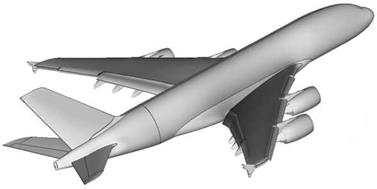Summary
This work has presented a mesh deformation module for the parallel simulation environment FlowSimulator. The module is based on the radial basis function interpolation approach.
|
Fig. 14 Complex high-lift configuration for a CFD/CSM coupled simulation applying the new tool FSDeformation. Shown is the deformed and non-deformed geometry (see wing tip) due to a different aerodynamic load case. |
The application fields of mesh deformation is manifold (unsteady simulations, shape optimization and aeroelasticity). In a next step, radial basis function interpolation and the mesh deformation module and its algorithm have been introduced. The module combines the radial basis function interpolation approach with a groupweighting and deformation-blending feature. This allows to move different surface groups/bodies independently from each other. Furthermore, the deformation blending provides an improved protection of boundary layer cells and allows the usage of unbounded radial basis functions and the extension of the radial basis function interpolation approach by a polynomial.
The group-weighting and deformation-blending uses the wall distance of the volume mesh nodes to the group boundaries. Hence a wall distance computation module has been implemented. It uses an advancing-front algorithm for the distance computation.
Additionally, the deformation module was extended with new deformation group features. These features allow to define deformation groups without creating base points and deformation vectors for this group. The features support far-field boundaries, symmetry planes or the rigid attachment of a boundary group to another boundary group.
Because the computational cost of the interpolation algorithm depends on the number of interpolation base points, the module offers four different methods for the reduction of the input base points. The first method uses an octree data-structure to select equidistant base points. The remaining three methods use in the first step this method as well. But in the second step they either use weighted distances for a modified equidistant reduction function, or they correct the interpolation error locally by selecting base points individually. The two weighted distance reduction methods use the difference to the mean deformation of the neighboring nodes or the interpolation error of the base points not selected for the weight computation. All the different methods have been compared in terms of performance and interpolation error. Here the locally operating error correction method has shown very good results in performance/interpolation error efficiency. But the method is limited to locally supported radial basis functions. Because the radial basis function Euclid’s Hat, which tends to infinity for an increasing input argument, has produced the lowest interpolation error, the interpolation error weighting method is the best advice.
The wall distance module and the deformation module have been parallelized with MPI. The theoretically perfect speedup of the interpolation method may only be affected by unbalanced node distributions over the parallel MPI processes.
The creation of the module FSDeformation by Airbus and its integration into the parallel FlowSimulator software environment has helped to reduce the uncertainties that occur in small geometry changes, which typically occur at aerodynamic shape design. Numerical shape optimization of components by using the improved grid deformation technique for unstructured grids has improved, reducing uncertainties related to mesh dependencies of the numerically obtained flow solutions.
Finally, applications for the deformation module in cooperation with the flow solver TAU and a structure module has been demonstrated. It has shown that the deformation module can play a key position in future computation chains using the simulation environment FlowSimulator with a perfect speedup for the mesh deformation method. Additionally, the example has illustrated that the coupling of different programs by using FlowSimulator can minimize intensive and time-consuming file input/output operations, due to the fact that both tools use the same main memory address space. The computational time and hence the cost of an optimization has been reduced considerably.












